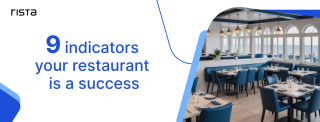Table of Contents
From multiplying fast-casual options to delivery-friendly fine dining, the lines between restaurant “types” are more blurred than ever. In our fast-paced world where every minute counts, quick-service restaurants (QSRs) have become the heartbeat of urban dining. With hustle-centric lifestyles and a demand for instant gratification, QSRs are thriving in India. In this blog, let’s understand how upcoming entrepreneurs can ace QSR success.
What is a QSR? 💡
A Quick Service Restaurant (QSR) is a type of eatery known for its fast food service, limited menu, and focus on speed and efficiency. QSRs are typically characterized by their counter service, where customers order, and the food is often packaged for takeaway. They prioritize convenience, with standardized operations designed to minimize wait times and offer affordable, consistent meals. Common examples include fast food chains, cafes, and snack bars. Popular cuisines that dominate QSR markets are burger joints, pizza chains, Mexican fast food, Asian fast food, coffee and bakery chains, etc.
They are experiencing both–a steady rise in popularity and a significant upgrade in food tech to cater to the increasing demands of today’s on-the-go diners.
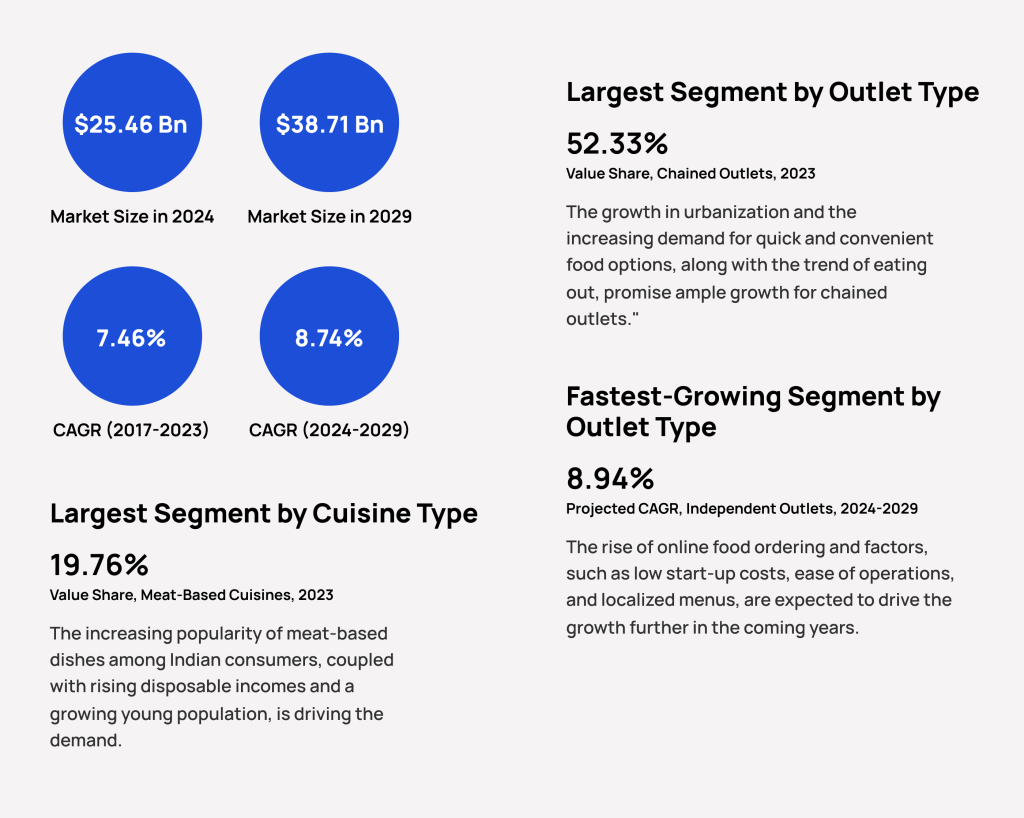
Although largely an urban phenomenon, the pattern is also emerging in tier two and tier three cities with better road connectivity, increased vehicle ownership, and a rise in income levels. For instance, Burger Singh – A homegrown burger chain has rapidly expanded across India, especially in tier two and tier three cities, offering a variety of unique burger options.
What will set your QSR apart?
QSR business is a high-stakes arena where speed, quality, and customer satisfaction are paramount. With countless competitors vying for consumer attention, let’s delve into the key ingredients to make your QSR a thriving business.
- Choosing the right format – Cloud or Physical?
Once you have decided to pursue a QSR, the next critical step is to choose between cloud-based operations and physical chains. Potential owners should consider factors like target audience and budget.
Cloud kitchens cater to customers who prioritize convenience and delivery, requiring lower initial investment and offering easier scalability. On the other hand, physical chains appeal to those who value dine-in experiences, helping to build strong local visibility and customer loyalty but demanding more capital for setup and expansion. Additionally, cloud-based operations provide better integration with data analytics and centralized management.
Evaluating these factors will help align the format with your business goals.
- Creativity is Crucial.
In a market saturated with QSR options, why should customers choose yours? To stay ahead of the competition, you need to get creative. Think beyond traditional offerings by introducing new flavors, inventive names, and unique presentations. For instance, if you’re selling burgers, don’t limit yourself to classic flavors—consider adding an Indian twist. However, creativity should align with your target audience.
While students might be eager to try something new, the corporate crowd may prefer familiar, authentic flavors. Tailor your creative efforts to meet the tastes and preferences of your specific customer base.
- Branding and Marketing
- Unique Branding: Develop a distinctive brand identity that stands out from the crowd. Consider unconventional color palettes, typography, and mascots.
- Packaging Innovation: Use packaging as a canvas for creativity. Explore unique shapes, materials, and designs that are both functional and visually appealing. Even seemingly mundane elements like tapes and labels can be opportunities for creative expression. Use unique designs, materials, or messages to leave a lasting impression.
- Content Marketing: Create engaging and shareable content that resonates with your target audience. Think beyond traditional advertising and explore storytelling, humor, or educational content.
Smoor’s packaging is designed to reflect its premium chocolate brand positioning. They often use elegant and minimalist packaging designs, with a focus on highlighting the quality of the chocolate inside.

Some key features of their packaging include:
- High-quality materials like cardboard boxes and foil pouches for a premium feel.
- Clean and uncluttered, with a focus on the chocolate itself.
- Eye-catching visuals, such as photographs of the chocolate or illustrations complement the flavor profile.
Aflatoon by Social’s quirky packaging is designed to appeal to its target audience of young, urban professionals who appreciate unique and innovative food experiences.
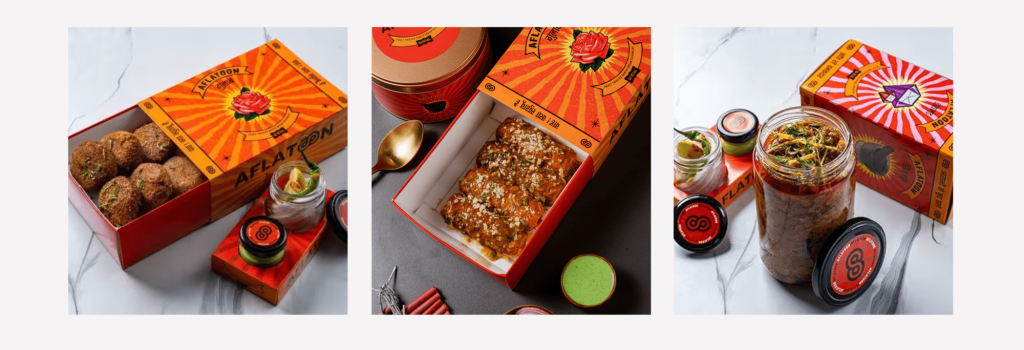
Some of the key features of their packaging include:
- Bright, eye-catching colors and bold graphics.
- Humorous slogans or quotes that resonate with their target audience.
- Sustainable materials, appealing to environmentally-conscious consumers.
- Menu and Product Innovation
- Unexpected Offerings: Introduce menu items that are unexpected or unconventional for a QSR sector. This could involve fusion cuisine, unique ingredients, or innovative preparation methods.
- Customization: Offer a high degree of customization to cater to individual preferences. This could involve build-your-own options, personalized toppings, or unique flavor combinations.
- Limited-Time Offers: Create a sense of urgency and excitement with innovative and appealing limited-time offers.
Samosa Party is a prominent example of an India-based QSR that has nailed the menu and product innovation game. While samosas are classic Indian street food, Samosa Singh has taken the humble samosa to new heights with its creative and diverse fillings.
Here are some of their innovative menu offerings:
- Fusion Flavors: Samosa Singh has experimented with fusion flavors, combining traditional Indian ingredients with international cuisines. For instance, they offer samosas filled with Italian-inspired fillings like spinach and ricotta or Mexican-inspired fillings like chicken and salsa.
- Unique Ingredients: The brand has introduced unique ingredients into their samosas, such as exotic cheeses, exotic vegetables, and even seafood. This has helped them attract customers who are seeking something new and exciting.
- Quality vs. Quantity: Striking the correct balance
- Quality is paramount: High-quality food is a cornerstone of QSR’s success. It drives customer satisfaction, loyalty, and positive word-of-mouth, setting businesses apart from competitors. A reputation for quality can attract a premium customer base.
- Focus on fewer, better SKUs: By limiting the menu to high-quality items, QSRs can streamline operations, improve efficiency, and deliver faster service. This ensures a more delightful customer experience while also maintaining the essence of the QSR experience—speed.
- Consistency is crucial: Maintaining consistent food quality requires rigorous quality control measures, standardized recipes, and well-trained employees. Restaurant management systems like Rista can help establish standardization in recipes, ingredients, etc., and optimize operations.
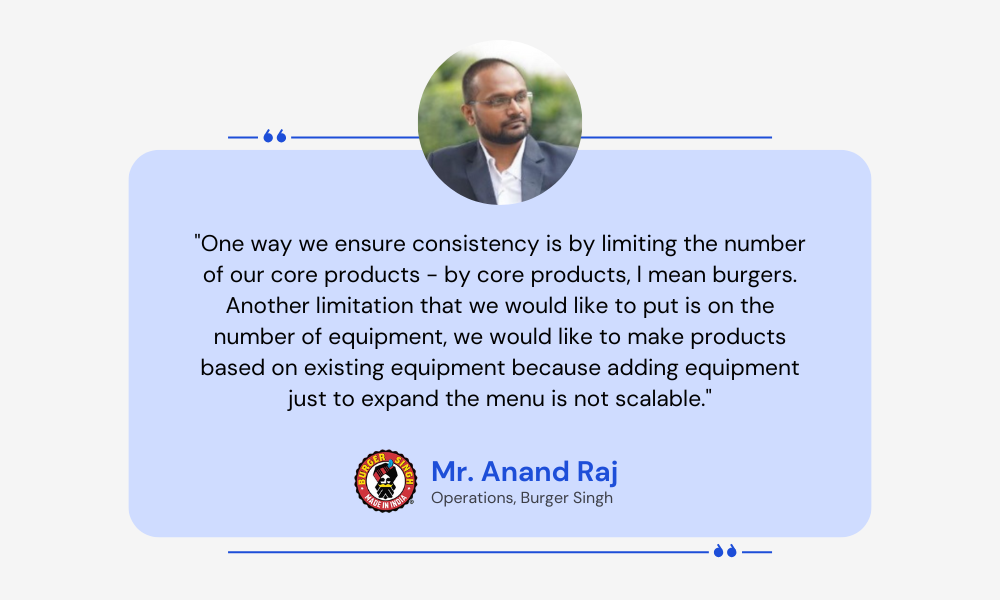
- Focus on fewer, better SKUs: By limiting the menu to high-quality items, QSRs can streamline operations, improve efficiency, and deliver faster service. This ensures a more delightful customer experience while also maintaining the essence of the QSR experience—speed.
The optimal balance between quality and quantity depends on various factors, including:
- Target market: Understanding the preferences of your target audience is crucial, as a younger demographic might appreciate a wider variety while a more mature audience might prioritize quality.
- Cuisine and concept: The type of cuisine and the overall concept of the QSR will also influence menu size. For example, a specialty burger joint might focus on a limited menu of high-quality burgers, while a casual dining chain might offer a broader range of dishes including burgers, sandwiches, wraps, etc.
- Operational efficiency: A smaller, more focused menu can be easier to manage and prepare, leading to faster service times and reduced costs.
- Pricing strategy: Additionally, a limited menu with high-quality ingredients can support a premium pricing strategy, while a larger menu might require more competitive pricing to attract customers.
NIC ice creams has successfully differentiated itself by focusing on a limited range of high-quality, natural ice cream flavors. Here’s how they’ve achieved this:
- Seasonal Flavors: Naturals introduces limited-time seasonal flavors, such as mango, chikoo, and litchi, to keep their menu fresh and exciting. This creates a sense of anticipation and encourages repeat visits.
- Unique Combinations: The brand experiments with unique flavor combinations, such as Alphonso mango with chilli, or rose with pistachio. These innovative offerings cater to a niche set of adventurous customers and create differentiation.
- Natural Ingredients: Naturals emphasizes the use of natural ingredients, such as fresh fruits, nuts, and pure milk. This aligns with the growing trend of healthy and sustainable eating, attracting health-conscious consumers.
- Customization: While the menu is limited, Naturals still offers customization options, such as adding toppings or choosing different cones or cup options. This allows customers to personalize their experience and feel more connected to the brand.
Today, QSR’s success hinges on a delicate balance of creativity, quality, and efficiency. By understanding the evolving consumer preferences, embracing innovative strategies, and prioritizing customer satisfaction, QSR businesses can thrive in the competitive Indian market. As the industry continues to evolve, the future of QSRs in India looks promising, with ample opportunities for growth and innovation.
4. Identify the Gap
Identifying and filling a gap in the QSR market can be a powerful strategy for achieving success. By offering a unique value proposition that addresses unmet customer needs, QSRs can differentiate themselves from competitors, build a loyal customer base, and increase profitability. A niche market often has less competition, allowing businesses to dominate the space and strengthen their market position. Moreover, seeking out gaps in the market can drive innovation and creativity, ensuring relevance and competitive advantage in the dynamic marketplace.
To find gaps in the QSR market, businesses can:
- Analyze Cuisine Popularity: QSRs like Bikanerwala have capitalized on the wide range of traditional Indian sweets, snacks, and savory dishes. They offer a variety of regional delicacies, including Rajasthani, Gujarati, and North Indian specialties. Chains like Sbarro and KFC have successfully adapted their menus to cater to Indian tastes, offering customized options and local flavors.
- Assessing Average Ratings and Reviews: QSRs can use platforms like Zomato and Google Reviews to analyze customer feedback and identify areas for improvement. Moreover, monitoring social media can provide insights into customer sentiment and identify trends. Faasos has actively engaged with customers on social media to understand their preferences and introduce new menu items.
- Seeking Inspiration from Other Regions: QSRs like Subway and Domino’s Pizza have successfully adapted their global concepts to the Indian market. Exploring trends in neighboring countries can inspire innovative offerings. For example, the popularity of bubble tea in Taiwan has inspired Indian QSRs like Boba Bhai to offer similar beverages.
abCoffee, Starbucks, and Barista are three prominent coffee chains in India, each offering unique experiences to customers.
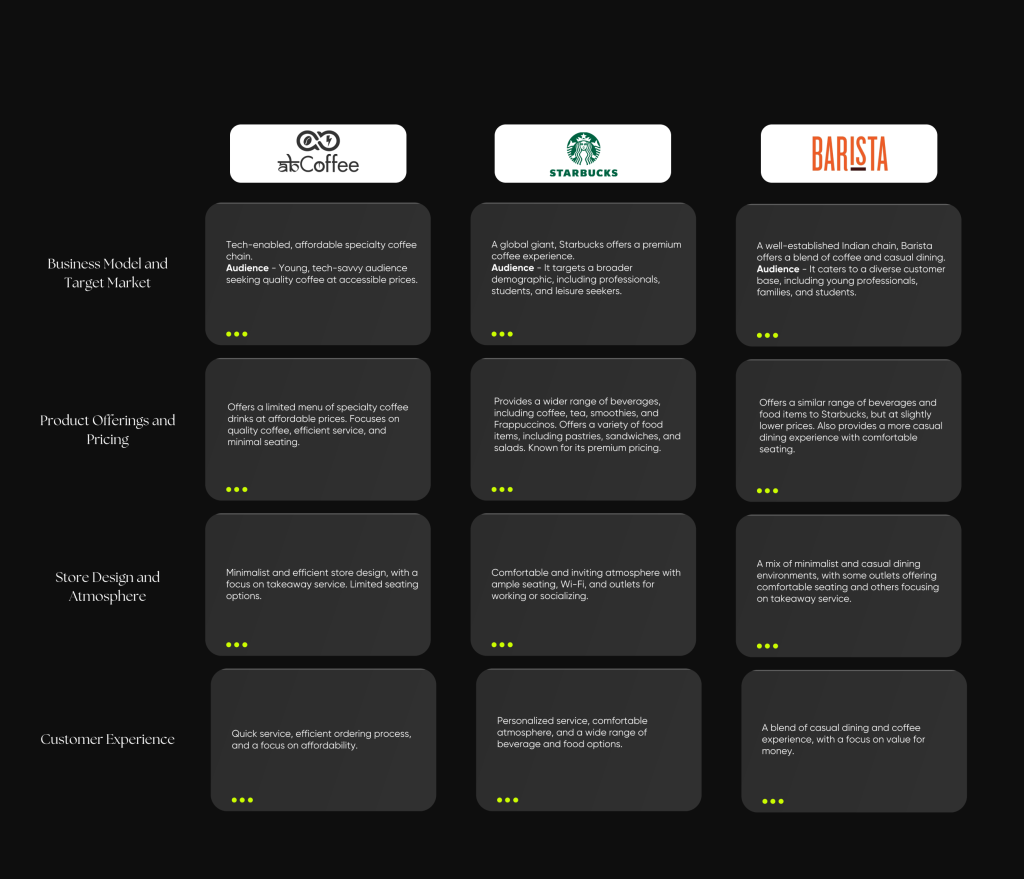
5. Leveraging a Direct-to-Customer Platform
A well-designed and user-friendly direct-to-customer website and ordering platform can provide a significant competitive advantage for a QSR.
- Personalized Experiences: A direct-to-customer platform allows QSRs to collect and analyze customer data, enabling them to offer customized recommendations, tailored promotions, and exclusive offers. This fosters a stronger customer relationship and can increase repeat business.
- Improved Brand Control: Owning a direct-to-customer platform gives QSRs greater control over their brand image and customer experience. They can curate their online presence, ensuring it aligns with their brand values and messaging.
- Data-Driven Insights: By analyzing customer data collected through their platform, QSRs can gain valuable insights into customer preferences, purchase behavior, and satisfaction levels. This data can be used to optimize menus, improve operations, and make data-driven marketing decisions.
- Reduced Reliance on Third-Party Aggregators: Owning a direct-to-customer platform can reduce a QSR’s reliance on third-party aggregators, which often charge commissions on each order. This can improve profitability and give the QSR more control over its brand and customer experience.
6. The Power of a Good QSR POS
A foundation for QSR’s success is a robust cloud-based POS solution. Manual operations – common in multi-outlet QSRs without cloud-based systems – are time-consuming and prone to human errors. This can lead to operational inefficiencies, customer dissatisfaction, and missed revenue opportunities.
Essential Features for a QSR POS
- Quick Order Taking: A QSR POS should facilitate efficient order-taking to minimize wait times and enhance customer satisfaction. Cloud-based POS systems offer the speed and scalability necessary to handle high-volume orders without compromising accuracy.
- Online Order Integration: Given the significant contribution of online orders to QSR revenue, a POS should seamlessly integrate with various online platforms. This includes food aggregators, websites, and apps. The POS should be able to segregate orders based on their source, providing insights into the most effective channels.
- Streamlined Order Preparation: A QSR POS should optimize order preparation by providing real-time updates to the kitchen. This includes displaying incoming orders, estimated preparation times, and delivery assignments. A Kitchen Display System (KDS) can further enhance efficiency by visually guiding kitchen staff through the order process.
- Effective Stock Management: A robust POS system should track inventory levels across multiple outlets, generate alerts for low stock, and estimate future requirements based on consumption patterns. This helps prevent stockouts, reduce wastage, and optimize costs.
- Central Kitchen Management: A POS system should provide solutions for managing central kitchen operations for QSRs with multiple outlets. This includes recipe management, outlet stock requirements, and automated purchase order generation. A streamlined central kitchen can directly contribute to improved sales and overall efficiency.
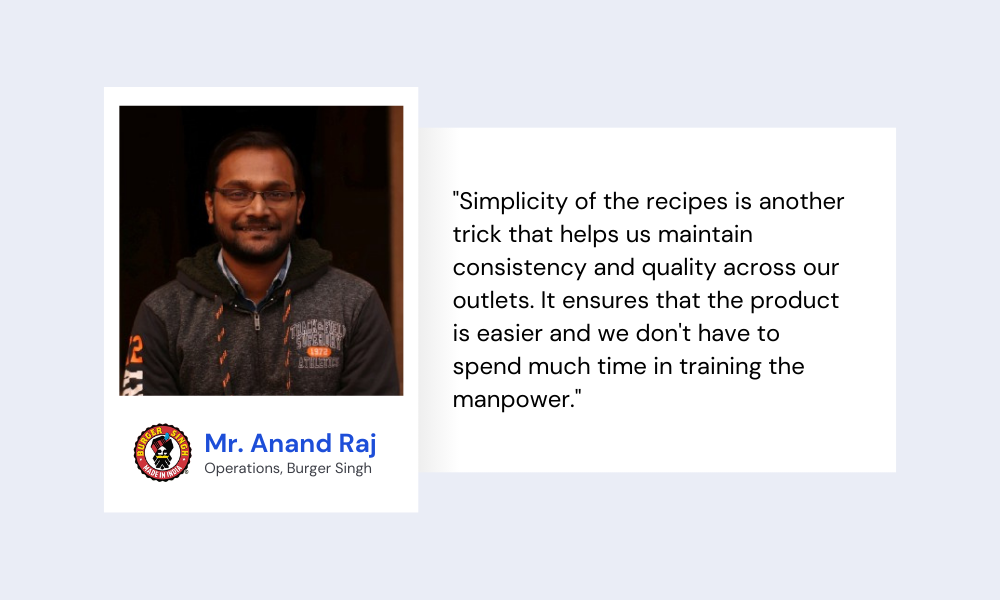
7. Work on Loyalty Programs and Discounts to Boost Engagement
By offering a combination of loyalty programs, discounts, and promotions, QSRs can significantly enhance customer loyalty and engagement. This can lead to increased repeat business, higher customer satisfaction, and improved profitability. Effective loyalty and discount programs should be simple to understand, relevant to customer preferences, and consistently applied to ensure fairness.
Domino’s Pizza is a great example of a QSR that has successfully implemented a loyalty and discount program. Their Domino’s Rewards program allows customers to earn points for every purchase, which can be redeemed for free pizzas, sides, or drinks. The program also offers exclusive deals and promotions for members.
Some of the key features of the Domino’s Rewards program include:
- Easy enrollment
- Flexible redemption options
- Exclusive offers
- Personalized recommendations
By offering a rewards program that is easy to use, flexible, and rewarding, Domino’s has been able to build a loyal customer base and drive repeat business.
8. The Power of Visuals
Images and descriptions of food items are essential tools for QSRs to attract customers and drive sales. Studies show that restaurants with visual content receive up to 70% more orders than those without.
- Increased online visibility: High-quality images and descriptive text can improve your search engine rankings and make your business more easily discoverable on platforms like Google and Yelp.
- Enhanced customer engagement: Visually appealing images and detailed descriptions can entice customers to try your dishes and create a more memorable dining experience.
- Boosted sales: Research shows that using images and descriptions can increase sales by up to 65%.
To maximize the impact of images and descriptions, consider the following tips:
- Highlight your most popular dishes with visually appealing images and detailed descriptions
- Invest in professional photography or use high-quality equipment and editing software to capture stunning images.
- Use relevant keywords in your image file names, alt text, and descriptions to improve search engine visibility.
| Pro-Tip💡 QSRs can encourage customers to review and rate their experiences. This can provide valuable feedback on the quality of service, food, and overall satisfaction. Positive reviews can attract new customers and enhance the brand’s reputation, while negative reviews can identify areas for improvement. QSRs can use review platforms like Google Reviews, Zomato, and TripAdvisor to collect and analyze customer feedback. |
Conclusion
Achieving QSR success is a complex endeavor that requires a holistic approach. By prioritizing speed, consistency, affordability, convenience, and building a strong brand, QSRs can increase their chances of thriving in a competitive market.
Remember, the key to success lies in understanding and meeting customer needs while maintaining operational efficiency and profitability.
